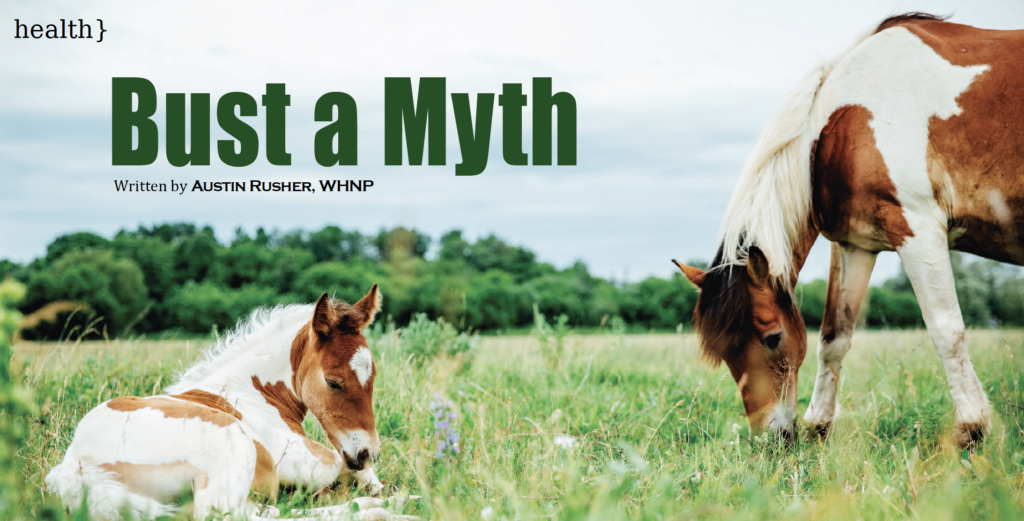Bust A Myth
Austin Rusher, WHNP

Growing up on a small ranch, the birds and the bees were never a mystery. My mother had an addiction to horses, all horse folk know the condition, and she loved making more of them. Our corrals were made from railroad ties and slender pine tree trunks with the branches roughly cut off by an ax. Most of our time at home was split between the corrals and barn, as my mother strived to create or develop her prospects.
Having friends over was occasionally problematic for kids not so blessed with this exposure and resultant knowledge of biology. My sisters and I took great joy in unraveling the mysteries of life, or conception, for these kids. After all, what’s better for a young kid than spreading forbidden knowledge?
Our friends would present their arguments about where babies come from.
Stories of storks, gifts from heaven, and swallowing watermelon seeds crossed our young conversations. In these cases, my sisters and I took the opportunity to set them straight…with visual aids from our barn.
If it wasn’t spring and mares were already settled, my mother was apt at making more of other types of animals. It seemed like we always had puppies, rabbits, and kittens or were waiting for their arrival. Looking back, our friend’s parents were probably not thrilled by our eager and unsolicited biology lessons.
Let’s start with Folic Acid. As a B vitamin, Folic acid is adept at helping to create healthy new cells. It is excellent for our hair, skin, nails and, you guessed it, growing babies. We love obstetrics and often see people for their first obstetric visit. Frequently, people have not started a Pre-Natal Vitamin (PNV) containing Folic Acid or only started after a positive home pregnancy test. This is still really helpful, but the ideal time to start Folic Acid is actually prior to conception.
Starting even three months prior to conception optimally reduces the risk of neural tube defects. Much of our food is actually fortified with Folic Acid. So, even if someone has not started a PNV prior to conception, outcomes are usually favorable. If you are of childbearing age, planning a pregnancy, or using only condoms and/or spermicides for birth control, consider starting a daily PNV or Folic Acid 400 mcg daily.
Speaking of pregnancies, a common myth that I hear, often at the first obstetric visit, is that a patient did not believe that she could conceive because she previously received a diagnosis of Poly Cystic Ovarian Syndrome (PCOS) in the past. THIS IS NOT TRUE! PCOS is a syndrome, or group of symptoms or conditions, that typically occur together. PCOS can have an effect on fertility. This effect varies from no issues to infertility with a wide range of possibilities in between.
According to the Rotterdam Criteria for diagnosis, two of three traits must be present. First, oligomenorrhea or amenorrhea (absent periods over a year). Second, hyperandrogenism which is increased, or increased signs of male-dominant hormones determined by lab work or symptoms like excessive hair growth. Finally, polycystic ovaries, which are many tiny fluid-filled sacs, or cysts, in the ovaries (typically found with ultrasound imaging).
If people have a rare or unpredictable period, it can be difficult to guess when they may ovulate. Understandably, there is a relatively high rate of unplanned pregnancies in women that have PCOS, believing that they can safely forgo birth control methods.
If you are suspicious that you have PCOS, you should talk to a health care provider. There are other long-term health concerns associated with PCOS. Taking active steps now to regulate your periods, and improve your overall health, will have positive effects throughout your life.
Our next topic has both a “yes” and “no” answer–our favorite type in medicine (har, har). Patients often believe that not having a period is unhealthy. This really depends on why someone is not having a period. A few reasons to safely not have a period are as follows: pregnancy confirmed in the uterus, postmenopausal status (naturally or surgically induced), certain congenital or genetic conditions, surgical causes such as ablation (where the lining of the uterus is essentially cauterized) or hysterectomy, and hormonal contraceptives including intrauterine devices (IUDs).
If a woman is not having a period outside of these scenarios, she needs further evaluation to determine the cause of their period’s absence and if intervention is indicated. As healthcare providers, we worry about the lining of her uterus, or her endometrium becoming unhealthy. If the endometrium is not “managed” with either a regular cycle, surgical intervention, or hormonal contraceptives, it can build up and become hyperplasic or pre-cancerous (becoming cancerous over time with the right combination of other factors). Notably, hormonal contraceptives are not only for birth control. They are also an option for period management and endometrial protection. This protective component is essentially keeping the endometrial lining thin, preventing it from proliferating unchecked.
Options are a wonderful thing, as is, shared and informed decision making. Nowadays, I am honored to clear up some common reproductive-related myths, provide some up-to-date information, and share some commonly unknown options.
If you want to learn more, have other questions, or want clarification on myths that you have heard related to women’s health, please come see us at Kalispell OB/GYN. You can now find us at our new location, in the Falls Building, at 165 Commons Loop, Suite E., Kalispell, Montana. Though our address has changed, our phone number has not.
Please feel welcome to call us at (406) 752-5252 to get your questions answered and help with any scheduling needs.
This article appears in 406 Woman magazine.
